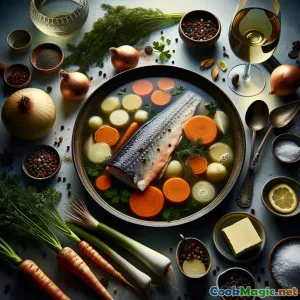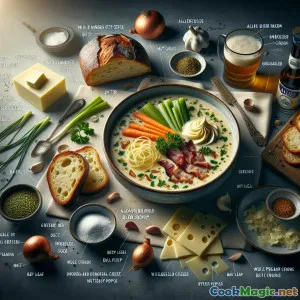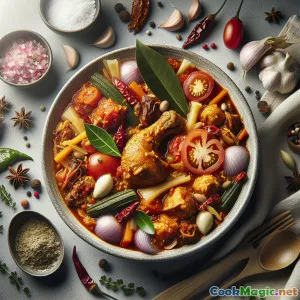
Kaldu Bergaya Pedesaan Bavaria dengan Akar Musim Dingin
(Rustic Bavarian Char Broth with Winter Roots)
(0 Ulasan)0
1,042
Juli 15, 2025
Laporkan Masalah
Bahan
-
500 grams Fillet ikan arktik
(Daging tanpa kulit, tanpa tulang, dipotong menjadi kubus 3cm)
-
2 medium Wortel
(Kulitnya dikupas dan dipotong dadu)
-
2 medium Wortel Parsnip
(Kulitnya dikupas dan dipotong dadu)
-
1/2 medium Akar seledri (akar seledri)
(Dadu)
-
1 large Bawang daun
(Dibersihkan dan diiris tipis)
-
2 small Kentang
(Jenis berserat, dikupas dan dipotong dadu)
-
1 medium Bawang
(Dihaluskan halus)
-
100 ml anggur putih kering
(Opsional untuk menambah kedalaman rasa)
-
1 liter Kaldu ikan
(Idealnya buatan sendiri atau rendah garam)
-
2 tbsp Peterseli segar
(Cincang halus, untuk hiasan)
-
1 whole Daun salam
-
3 whole buah juniper
(Dihancurkan ringan)
-
5 whole Biji lada hitam utuh
-
2 tbsp Mentega
(untuk menumis sayuran)
-
1 tsp Kulit lemon
(Parutan segar)
-
to taste Garam laut
-
to taste Lada hitam baru giling
(Daging tanpa kulit, tanpa tulang, dipotong menjadi kubus 3cm)
(Kulitnya dikupas dan dipotong dadu)
(Kulitnya dikupas dan dipotong dadu)
(Dadu)
(Dibersihkan dan diiris tipis)
(Jenis berserat, dikupas dan dipotong dadu)
(Dihaluskan halus)
(Opsional untuk menambah kedalaman rasa)
(Idealnya buatan sendiri atau rendah garam)
(Cincang halus, untuk hiasan)
(Dihancurkan ringan)
(untuk menumis sayuran)
(Parutan segar)
Nutrisi
- Porsi: 4
- Ukuran Porsi: 1 mangkuk (300ml)
- Calories: 310 kcal
- Carbohydrates: 0 g
- Protein: 27 g
- Fat: 10 g
- Fiber: 5 g
- Sugar: 7 g
- Sodium: 760 mg
- Cholesterol: 55 mg
- Calcium: 72 mg
- Iron: 1.8 mg
Instruksi
-
1 - Menyiapkan Sayuran dan Ikan:
Potong wortel, parsnip, seledri, dan kentang menjadi kubus kecil yang seragam. Iris daun bawang dan cincang halus bawang bombay. Potong fillet ikan arktik char menjadi kubus 3cm dan keringkan. Sisihkan.
-
2 - Tumis Aromatik:
Dalam panci Belanda besar atau panci sup, lelehkan mentega dengan api sedang. Tambahkan bawang bombay dan daun bawang; tumis sampai transparan tetapi tidak kecoklatan. Masukkan wortel, parsnip, seledri, dan kentang. Tumis selama tambahan 5 menit.
-
3 - Deglazir dan Bumbui:
Tuang anggur putih (jika digunakan) dan gunakan sendok kayu untuk mengikis sisa cokelat dari dasar. Biarkan anggur mengurangi selama 2 menit. Tambahkan daun salam, buah juniper yang dihancurkan (jika digunakan), dan merica.
-
4 - Rebus kaldu:
Tambahkan kaldu ikan. Didihkan perlahan, lalu kecilkan api agar tetap mendidih. Masak, dengan setengah penutup, selama 20–25 menit atau sampai sayuran akar lunak.
-
5 - Mengukus Ikan Arktik:
Dengan hati-hati tambahkan kubus ikan arktik ke dalam kaldu yang sedang mendidih. Rebus perlahan selama 5–6 menit, sampai ikan matang sempurna dan mudah hancur tetapi masih tetap lembab.
-
6 - Selesaikan dan Sajikan:
Hilangkan daun salam dan buah juniper. Bumbui kaldu dengan garam dan lada hitam bubuk segar sesuai selera. Sajikan kaldu dan ikan dalam mangkuk. Hiasi dengan peterseli segar dan parutan kulit lemon tepat sebelum disajikan.
Potong wortel, parsnip, seledri, dan kentang menjadi kubus kecil yang seragam. Iris daun bawang dan cincang halus bawang bombay. Potong fillet ikan arktik char menjadi kubus 3cm dan keringkan. Sisihkan.
Dalam panci Belanda besar atau panci sup, lelehkan mentega dengan api sedang. Tambahkan bawang bombay dan daun bawang; tumis sampai transparan tetapi tidak kecoklatan. Masukkan wortel, parsnip, seledri, dan kentang. Tumis selama tambahan 5 menit.
Tuang anggur putih (jika digunakan) dan gunakan sendok kayu untuk mengikis sisa cokelat dari dasar. Biarkan anggur mengurangi selama 2 menit. Tambahkan daun salam, buah juniper yang dihancurkan (jika digunakan), dan merica.
Tambahkan kaldu ikan. Didihkan perlahan, lalu kecilkan api agar tetap mendidih. Masak, dengan setengah penutup, selama 20–25 menit atau sampai sayuran akar lunak.
Dengan hati-hati tambahkan kubus ikan arktik ke dalam kaldu yang sedang mendidih. Rebus perlahan selama 5–6 menit, sampai ikan matang sempurna dan mudah hancur tetapi masih tetap lembab.
Hilangkan daun salam dan buah juniper. Bumbui kaldu dengan garam dan lada hitam bubuk segar sesuai selera. Sajikan kaldu dan ikan dalam mangkuk. Hiasi dengan peterseli segar dan parutan kulit lemon tepat sebelum disajikan.
Informasi Lebih Lanjut: Kaldu Bergaya Pedesaan Bavaria dengan Akar Musim Dingin
Bavarian Char Broth with Root Vegetables: Story, Culture & Chef’s Notes
Bavaria—the emblem of southern Germany—may be best known for its breezy mountain landscapes, hearty Oktoberfest fare, and world-class breads. Yet, Bavaria is also a region where crystal-clear lakes meet alpine agriculture, inspiring some of Europe’s most honest, earthy soups. Among them, fish broths hold a timeless place, linking local fishmongers, mountain farmers, and village cooks who invented ways to elevate humble roots and lakeside bounty. Bavarian Char Broth with Root Vegetables seeks to channel those farmhouse traditions in a bowl.
History and Cultural Significance
The concept of turning lake fish into broth hails from rural necessity. In lakeshores like Chiemsee, char, trout, and pike were caught early and often. Root vegetables, perfectly suited for Bavaria's cool climate and rocky soil, could be stored through harsh winters. Home cooks developed broths to capture the essence of both—meals that were nourishing and restorative through winter, but elegant enough for a Sunday table.
While char is most notably fished in the icy lakes of the Alps, it has become symbolic of regional pride. The aromatic root blend mirrors the age-old customs that honored subtle sweetness and gentle earthiness. Traditionally, such broths ("Fischsuppe" or more specifically, "Saiblingseintopf" for char) were communal, served to warm hands and spirits alike.
Unique Aspects and Personal Chef Insights
• Char Flavor: Arctic char brings a luxurious, buttery flavor somewhere between trout and salmon, but a leaner texture and delicate flake ideal for broths—it never overpowers the roots and aromatics. • Root-Rich Base: Carrots, parsnips, celeriac, and potato create natural sweetness and depth, while leek and onion add a savory foundation. Celeriac in particular is a regional favorite, giving an unmistakable "Old World" note. • Juniper, Bay, and Wine Touches: A whisper of crushed juniper and dry white wine (a nod to the region's vineyards and forests) weaves complexity without crowding the palate. • Lemon Zest & Parsley: These finishing touches, though seemingly simple, are traditional methods to freshen up the deep flavors just before serving. They add brightness—and a hint of spring even in mid-winter.
Cooking Tips & Best Practices
- Stock Selection: Choose a high-quality, gently seasoned fish stock—homemade is best. A splash of white wine helps break up any fishiness, integrating earthier vegetable flavors flatly and evenly. Vegetable or chicken stock can substitute if needed.
- Poaching Fish: Bring the broth temperature down before poaching the char to ensure the cubes stay succulent and tender. Overcooking will lead to flakiness rather than pleasant firmness.
- Serving Variation: This soup craves a hunk of rustic rye or sourdough bread, and traditionalists might also stir in a handful of fresh garden herbs in the final moments for even more color.
Personal Reflection
As a chef, I find rich nostalgia in recipes like this. You can taste the careful stewardship—nothing wasted, everything celebrated. Today, this Bavarian Char Broth invites us to simmer down and prioritize soulful, wholesome food. The broth’s savory complexity and sparkling fresh finish, paired with the comforting weight of root vegetables, represent both togetherness and tenacity found in Alpine communities. It's an ideal winter lunch, first course, or a light but hearty weekend dinner, particularly when snow lines the trees outside your kitchen window.
Conclusion: Why You Should Try It
Bavarian Char Broth with Root Vegetables is equal parts historical homage and cozy, modern comfort. Every element—fish, root, leaf—contributes symbiotically to something both satisfying and refined. Let this hearty recipe become a new favorite on brisk days, whenever you crave both warmth and a taste of Europe’s lakeside heritage.
























